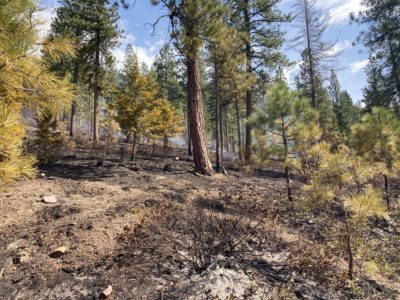Over the last few weeks, a number of private landowners, organizations and public agencies have conducted prescribed burns in the Blackfoot River watershed with the goal of enhancing both forest health and community safety. While this fills the skies with smoke for a few days, burning this time of year has numerous benefits for both forested landscapes and communities.
Cindy Super is the Forestry and Prescribed Fire Coordinator for the Blackfoot Challenge, a community-based organization that facilitates collaborative conservation and stewardship in the Blackfoot River watershed. She coordinates the Challenge’s Prescribed Fire Workgroup, whose goal is to support an increased use of prescribed fire as a management and restoration tool across private and public land in the watershed.
“Fire was an essential component of the Blackfoot prior to the 1900s. Native Americans routinely lit fires in the spring and fall for a variety of reasons, and we are starting to learn more about the impacts of excluding fire for so long. Prescribed fires are actually one of the greatest tools we have to reduce those late-summer wildfires from becoming so big and intense,” said Super.
The primary goal of conducting prescribed burns is to decrease the risk of large wildfires in the future. Low-intensity, controlled fires typically consume only small trees and debris on the forest floor, thereby decreasing the amount of fuel available to contribute to future wildfires and increasing the safety of residents, their property, and the firefighters on the front lines. Prescribed fire has the added benefit of enhancing the health and vigor of native vegetation, improving wildlife habitat, and increasing the forest’s resilience to insects and disease.

Dave Atkins is a private landowner in the Twin Creeks area of the lower Blackfoot. He worked with the Blackfoot Challenge to conduct a prescribed fire on his property this spring. In years prior, he hired a local contractor in conjunction with The Nature Conservancy – the adjacent landowner – to log the property in order to ensure the burn would be both effective and safe. The Montana DNRC provided funding to support the effort.
“This underburn was the final chapter of my restoration story. It cleans up the fine fuels that drive wildfires, it rejuvenates the plants under the trees, improving habitat for the bears, birds, deer and elk that we love to see, and it protects the trees that will be my children and grandchildren’s inheritance. A healthy, resilient, sustainable forest is a situation where you can have your cake and eat it too,” said Atkins.
On the day of the burn, Atkins and Super were accompanied by multiple private contractors with training and expertise in prescribed burning.
“Many hours, and in some cases years, of planning go into a prescribed burn. Recently we’ve been lucky enough to have the right combination of weather, fuel conditions, and personnel available to have several prescribed burns,” said Super.
A few miles up the road, the Bureau of Land Management burned about 600 acres in the Dunnigan Gulch/Ninemile Prairie area over the same period. Similar to Atkins’ property, the BLM burn occurred on lands with a long history of industrial timber management. This burn also included roughly 50 acres of ground owned by The Nature Conservancy. Trained personnel from the Bureau of Land Management, The Nature Conservancy, the US Forest Service, and the Blackfoot Challenge were on-site to support the effort.

Erin Carey, BLM’s Missoula Field Manager and Blackfoot Challenge Board Partner, said the Missoula Field Office typically burns between 400 and 600 acres per year, though they hope to be burning upwards of 1,000 acres per year on the lands they manage in the Blackfoot.
“It is exciting to see these efforts start to come together across the landscape and across land ownerships,” said Carey. “Coordinating in this way is how we move the needle and achieve ecosystem resilience and community protection at a scale that matters.”
Other entities either conducting or supporting prescribed burns in the Blackfoot this spring include The University of Montana, Montana Fish, Wildlife & Parks, the Montana DNRC, and numerous private landowners across the watershed.
If you are interested in visiting one of the prescribed fire locations in the Blackfoot and learning more about this stewardship tool, the Blackfoot Challenge and partners will be hosting a tour in late May. Shoot us a note at info@blackfootchallenge.org to learn more and reserve a spot.
